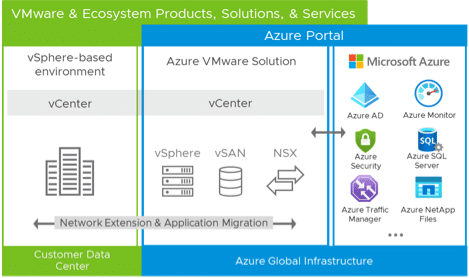By partnering with VMware, Azure has rolled out Azure VMware Solution to capitalize on existing VMware investments, skills, and tools while leveraging the power of the cloud. Azure VMware Solution is a jointly engineered offering from Microsoft and VMware that can simplify the process and speed up the transition to cloud computing while reducing long-term costs.
By partnering with VMware, Azure has rolled out Azure VMware Solution to capitalize on existing VMware investments, skills, and tools while leveraging the power of the cloud. Azure VMware Solution is a jointly engineered offering from Microsoft and VMware that can simplify the process and speed up the transition to cloud computing while reducing long-term costs.
Azure VMware Solution
Challenges persist as advancements in application development have significantly contributed to the rapid transition of on-premises workloads to the cloud for organizations worldwide. In contrast, organizations weigh the operation and migration issues, workload disruption, and performance concerns.

Typical challenges when pursuing a cloud strategy include:
- Inconsistent operations between on-prem and cloud
- Lack of skills needed to adapt to new processes
- Disparate management tools and security controls
- Inconsistent application SLAs
- Machine format incompatibility
- The high upfront cost for refactoring and revalidation
- Reduced agility associated with workload refactoring and migration
Azure VMware Solution addresses these concerns by providing a unified VMware Software-Defined Data Center (SDDC) integrating VMware vSphere, VMware vSAN, and VMware NSX-T virtualization technologies. Also included is VMware HCX, a workload mobility platform designed to simplify migrations to the cloud.
The Solution SDDC runs natively on dedicated bare-metal Azure infrastructure and capitalizes on existing VMware investments, skills, and tools. This also allows for operational consistency that leverages the scale, performance, and innovation of Azure.
As organizations evaluate a cloud migration strategy, this Azure/VMware combo can reduce costs, increase efficiency, and modernize applications. Leveraging existing VMware investments, skills, and tools while maintaining operational consistency with standard VMware technology, including vSphere, HCX, NSX-T, and vSAN, addresses many workload migration questions. There’s continuity, scale, and fast provisioning for VMware workloads migrating to global Azure infrastructure in the Azure Cloud. Pricing varies some depending on region, but here’s what it looks like for an AV36 instance in East US, near our location.

The first Azure VMware Solution deployment will consist of a private cloud containing a single cluster. It is necessary to define the number of hosts you want to deploy to the first cluster for your deployment.
For each private cloud created, there’s one vSAN cluster by default. Clusters can be added, deleted, and scaled. The minimum number of hosts per cluster and the initial deployment is three. Clusters can scale between three (minimum) and 16 (maximum) ESXi hosts.
vSphere and NSX-T Manager are used to manage most other aspects of cluster configuration or operation. All local storage of each host in a cluster is under the control of vSAN.
Overall, the Azure VMware Solution leverages access to familiar management tools used in on-prem VMware deployments. Management tools such as VMware vRealize Cloud Management, Tanzu, Site Recovery Manager, NSX Advanced Load Balancer, and SD-WAN can be used as cloud migration progresses. The lines between on-prem and Azure Cloud become blurred with the introduction of Azure VMware Solution.
Azure VMware Solution Product Page
Engage with StorageReview
Newsletter | YouTube | Podcast iTunes/Spotify | Instagram | Twitter | Facebook | TikTok | RSS Feed
